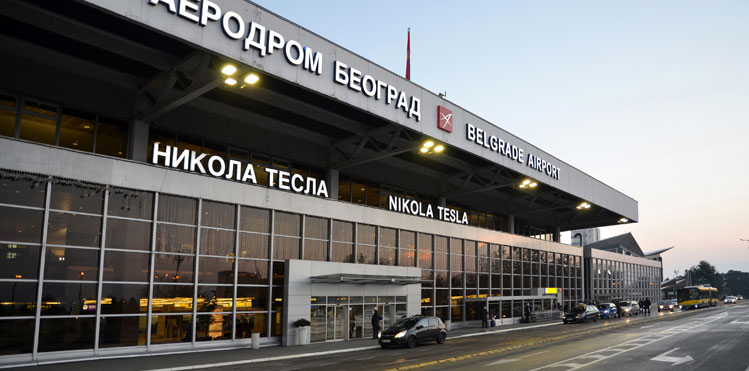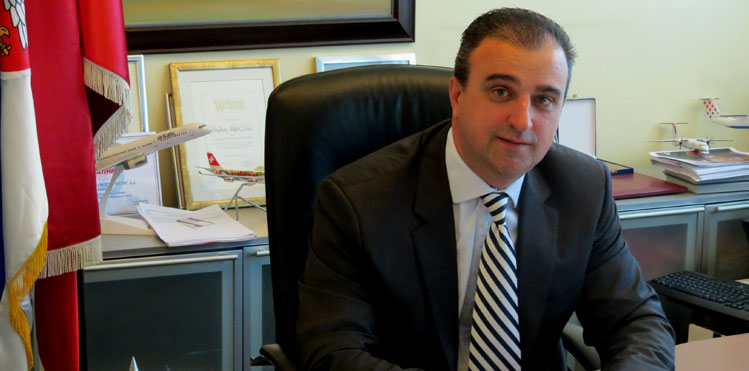The Serbian aviation industry is entering a new era. The number of people travelling to the Southeast European destination and its thriving capital has multiplied since 2013, when Etihad acquired a 49% stake in the nation’s struggling flag carrier JAT Airways, rebranding it as Air Serbia and introducing a wealth of new routes that have elevated the country’s air transport industry to new plains. Developments in business policy and changes in regulation – including the long-awaited signing of the agreement on long-haul traffic between Serbia and the US – have opened the floodgates of opportunity for auspicious international connections, while the Serbian populous is growing ever more mobile, as is evident in the spiralling traffic figures at its primary gateway.
Last year passenger numbers at Belgrade Nikola Tesla Airport far surpassed record throughput, with 4.64 million travellers passing through the airport in 2014 – a 31% year-on-year increase that propelled it to the position of fastest growing airport in Europe, and greatly exceeded the average 4-5% rise. Growth has continued into the first half of this year, and its flourishing traveller volume has firmly secured Belgrade Airport’s standing among the continent’s leading capital airports. In the first four months of 2015 the number of passengers departing and arriving at Belgrade increased by 10%, the number of aircraft movements by 5%, and cargo traffic by 19%. Its escalating passenger figures have seen Belgrade Airport become a primary air transport hub in the Balkan region, and have set it on course, explained CEO Sasa Vlaisavljevic, to manage five million passengers annually for the first time since its opening by December of this year.

Serbia’s primary gateway is investing more than €20 million in the expansion and modernisation of its facilities in order to manage the burgeoning passenger numbers it is experiencing, as Serbia’s air transport industry flourishes.
Belgrade Nikola Tesla Airport also registered a record €28.3 million net profit in 2014 – the most significant in its 52-year history – and its value, Vlaisavljevic reported, increased by several hundred million euros, primarily due to cost rationalisation, solid commercial policy and the remarkable expansion of Air Serbia. “It is obvious that air traffic is experiencing expansion in our country, and this trend is still on the rise,” Vlaisavljevic enthused. “I am glad that Belgrade Airport is a part of the successful economic development of the country, and my team and I are doing our best to improve our business even more.”
The great momentum of Belgrade Airport’s business was met with readiness, and plans for the development of the airport’s infrastructure to meet its burgeoning passenger numbers are now well underway. More than €20 million is being invested in projects aiming to increase the quality and capacity of its services, “both in terms of increased possibilities for handling a larger volume of air traffic, and increased comfort of our customers – the airlines, operators we have cooperated with for many years, and the passengers themselves”, Vlaisavljevic explained.
“We have to contemplate airport capacities at least several years ahead. Existing infrastructure capacities are sufficient for the current volume of air traffic, but responsible business operation implies the timely preparation for the expansion,” he said. “Because of this, the airport began a two-year investment cycle worth a total of around €20 million, which will enable the increase of the quality and capacity of services both in terms of increased possibilities for servicing a larger volume of air traffic and increased comfort of customers – all of those entities who in realisation of their primary activities use the airport capacities.”

Belgrade Nikola Tesla Airport CEO Sasa Vlaisavljevic: “It is realistic that in the near future Belgrade Airport will take a leading position not only in the region, where it is undoubtedly a leader, but also in Europe.”
The airport’s short-term redevelopment strategy involves the expansion of its existing capacities, including a terminal expansion alongside the extended C apron to a total area of 11,000sqm, the renovation of Terminal 1, the construction of a €3.5 million apron for de/anti-icing of aircraft, and building of the official checkpoint D.
Taking a “leading position”
The €15.2 million extension of terminal hall C will be the first greenfield project to take place at Belgrade Nikola Tesla Airport for some years, and will also see the introduction of new passenger boarding bridges, primarily intended for the use of large, wide-body aircraft capable of long-haul service. Two common waiting lounges will also be constructed – the waiting room on the upper floor will be equipped with four passenger boarding bridges, while the second, ground floor lounge will have four gates with open positions.
In Terminal 1, meanwhile, works have begun on a €2.16 million modernisation, which will see the opening of a new border crossing. Once it is completed, passengers departing from this terminal will have direct access to waiting rooms and finger halls where “a large number of commercial facilities will be available, following the example of world airports,” Vlaisavljevic said. “This reorganisation will influence the increase of service level on both terminals, and will also create the opportunity for Terminal 1 to operate independently in despatching passengers on their flight.”
“I would point out,” he continued, “that Belgrade Nikola Tesla Airport will develop infrastructurally, while at the same time we shall purchase equipment with the aim of technical and technological development. This means that apart from adaptation and expansion of infrastructural capacities, the airport will constantly be modernised and increase its operability. It is realistic that in the near future Belgrade Airport will take a leading position not only in the region, where it is undoubtedly a leader, but also in Europe.” It is expected that this short-term investment cycle will be completed by 2017.
“By expanding capacities we create conditions for better operation of the domestic construction industry, Belgrade – and Serbia – will be more attractive in terms of business and tourism, and the opening of new routes means passengers will have a more diversified offer,” Vlaisavljevic enthused. “We are in constant contact with the relevant state institutions dealing with tourism. A part of our passengers are also tourists, and certainly their presence and development of this branch of the economy have an effect both on the airport and on the overall economic development of the country.”







